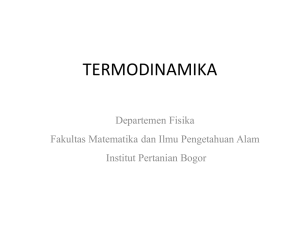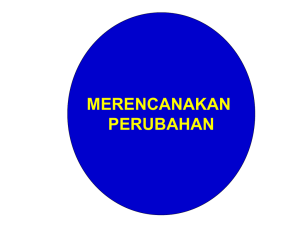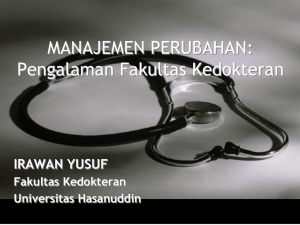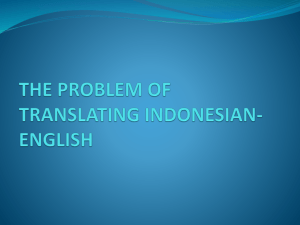Strategic Change - ardiansyahzein.com
advertisement
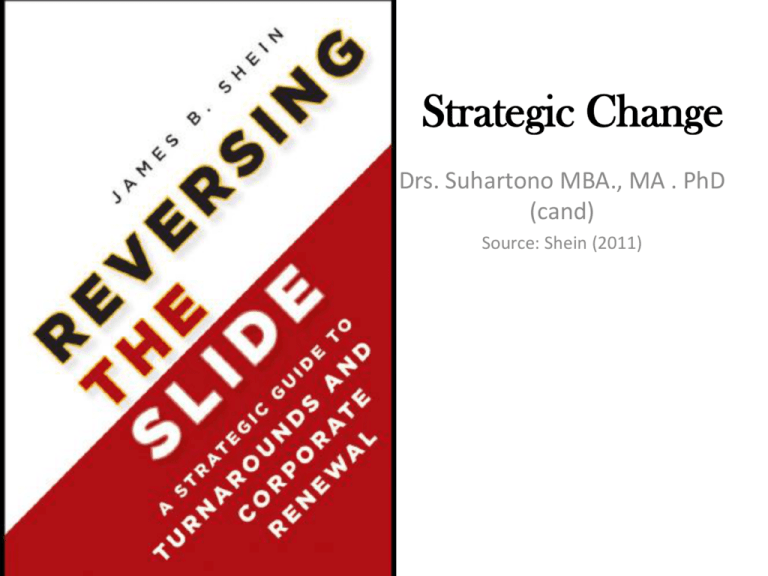
Strategic Change Drs. Suhartono MBA., MA . PhD (cand) Source: Shein (2011) Process Models of Organization Change Strategic Change: The Paradox of Revolution and Evolution DISCONTINUOUS CHANGE CONTINUOUS CHANGE Emphasis on Revolution over evolution Evolution over revolution Strategic change as Disruptive innovation/turnaround Uninterrupted improvement Change process Creative destruction Organic adaptation Change magnitude Radical, comprehensive, dramatic Moderate, piecemeal, undramatic Pace of change Abrupt, unsteady, intermittent Gradual, steady, constant Change requires Sudden break with status quo Permanent learning and flexibility Environmental jolts Trigger shock therapy Require continuous adjustment Change pattern Punctuated equilibrium (Equilib Gradual development is not the ends) Change Management Effectiveness Successful Change Post Implementation Inkorporasi Refreezing Implementation Implementasi Moving Concept & Design Inisiasi Unfreezing Bus Need Awareness Desire Knowledge Ability Reinforcement Resistance to Change (Connor, 1995) • • • • • • • • • Lack of Trust: distrust of the people who propose it. Belief that change is unnecessary: if the current way of doing things has been successful in the past and there is no clear evidence of serious problems that require major change. Belief that the change is not feasible: It seems unlikely to succeed. Economic threats; personal loss of income, benefit, or job security. Relative high cost: cost higher than benefit. Fear of personal failure: some expertise obsolete and new ones that may prove too difficult to master. Loss of status and power: shift in relative power and status of individual and subunits. Threat to values and ideals: inconsistent with strong values and ideals. Resentment of interference: do not want to be controlled by others. Reactions To Change • • • • Denial Confusion Loss Anger “People fear the uncertainties of change. The slightest suggestion that things won’t stay the same can cause panic…but the real problem isn’t the change…it’s people’s reaction to that change.” -Dr. Alan Zimmerman Individual Perception and Changes (Satier Model) Integration DENIAL COMMITMENT Pemungkiran KINERJA Understanding Shock Experimentation Frustasi Acceptance RESISTANCE EXPLORATION WAKTU Mengenali Fase Perubahan Persepsi • Denial Tidak percaya – Apatis – Tidak peka Ada aktivitas tapi tidak ada kelanjutan – – • Resistance Kemarahan – Depresi – Pembangkangan – Menyalahkan – Absen – • Exploration – – Berambisi – Over preparation (banyak rencana) – Kebingungan mengenai prioritas Tidak terkoordinasi, bekerja sendiri-sendiri. • Commitment – – Fokus pada hasil – Paham benar mengenai langkah apa selanjutnya – Ada kepuasan kerja – Bersiap dengan perubahan lebih lanjut Percaya-diri ata kemampuan beradaptasi atas perubahan. Prinsip • Acting better than planning (tindak lanjut lebih membuktikan dari pada rencana). Perbaiki Kesiapan Berubah dan Pakailah cara Komunikasi sesuai perkembangan Persepsi Karyawan dalam setiap tahapan berubah. • Think Big, Start Small, Act Now (Bergagasan besar, dan segera mulai dari yang bisa dikerjakan walaupun kecil). • Mulai dengan antusias sejak awal. Ajak staff yang antusias di awal implementasi. • Jangan mengharap semua langsung berubah pada saat inisiasi. • Berikan bantuan dan dukungan setelah inisiasi. • Berikan penghargaan / pujian untuk setiap langkah keberhasilan walau itu langkah yang (masih) kecil. Komunikasi dan Perubahan DENIAL RESISTANCE COMMITMENT Tell Ask Ask Tell EXPLORATION Denial - Tell • Confront: Hadapkan pada kenyataan mengenai adanya tuntutan perubahan. • Explain: Jelaskan alasan keharusan berubah. • Explore: Gali perubahan sikap dan perilaku apa yang diperlukan. • Show: tunjukan sikap dan perilaku apa yang harus lakukan. • Allow: berikan waktu untuk mencerna dan merasakan perubahan yang dibutuhkan. Resistance - Ask • Listen: dengarkan apa yang menjadi keprihatinan dan kekawatiran staff dan tawarkan support. • Acknowledge: Maklumi perasaan dan kegundahan. • Allow: dengarkan dan lapangkan dada untuk menerima komplain. • Support: ikutlah berempati atas suatu kerugian atas perubahan yang terjadi. • Bersegera: menanggapi sesuatu hasil dari usaha berubah, walau sekecil apa pun. Exploration - Tell • Konsentrasi pada prioritas perubahan. • Fokuskan pada setiap tahap prioritas. • Tentukan ukuran keberhasilan untuk setiap prioritas. • Pandu, latih, dan dampingi langkah-langkah berubah. • Mulai mengaktifkan pembentukan tim kerjasama. Commitment - Ask • Akui dan rayakan sukses yang dicapai oleh seseorang atau tim, berikan penghargaan (tidak harus materi) untuk setiap kemajuan dan keberhasilah. • Umpan Balik: diberikan sepanjang perubahan sedang berjalan. • Rencana ke depan berbagai kemungkinan perubahan berikutnya. • Membangun kerjasama tim yang telah ada agar lebih solid dan lebih kuat lagi. Komunikasi dalam Perubahan DENIAL RESISTANCE COMMITMENT Tell Ask Ask Tell EXPLORATION Berurut, Jangan Meloncat Berapa banyak dari Anda di sini sebetulnya yang TAKUT dengan PERUBAHAN? Kalau ada merasa takut dengan perubahan TOLONG ACUNGKAN TANGAN 19 Berapa banyak menurut anda ORANG-ORANG di luar sana yang takut dengan perubahan? Kalau anda pikir banyak orang lain takut (dengan perubahan), TOLONG ACUNGKAN TANGAN 20 Fakta apakah yang berbicara mengenai ‘pengakuan’ tadi? Kebanyakan dari kita takut pada perubahan. Bahkan ketakutan itu lebih besar dari pada apa yang kita ingin akui terhadap diri sendiri. 21 Kita sering lupa melihat diri sendiri pada saat melihat ‘banyak orang’ Apa yang kita persepsikan mengenai kebanyakan orang, sebenarnya merupakan reflek-pikir (mirroring) bahwa kita sendiri seperti yang kita pikirkan mengenai orang-orang lain tersebut. 22 “Perhaps the only person who likes change is a wet baby.” Anonymous 23 Based on the #1 Bestselling Business Book 24 Understanding Through Animation Who Moved My Cheese? The Movie 25 SNIFF? Who can smell change in the air. 26 SCURRY? Who goes into action immediately. 27 HEM? Who does not want to change. “It’s Not Fair!” 28 HAW? Who is startled by change, but then laughs at himself, changes and moves on to enjoy New Cheese. 29 The Sniff, Scurry, Hem & Haw Parts of Ourselves We may have a little bit of each of these characters in us—which we can use to help us deal with change. 30 Social Change Diffusion of Innovations Source: Rogers, Everett M. Diffusion of Innovations, Fifth Edition. NY: Free Press. Social Change Adopter Categories People and organizations typically can be classified according to the timing of their adoption of new innovations. 1. 2. 3. 4. 5. Innovators: Adventuresome, high risk. Early adopters: Thoughtful, early adoption. Early majority: The first to follow the lead of opinion leaders. Late majority: Responding to pressure to adopt. Laggards: Do not adopt for a variety of reasons. Social Change Social Change Definitions An innovation is an idea, practice, or object that is perceived as new. What might seem familiar to some is new to others. Innovations can be material or nonmaterial. Diffusion is a process whereby an: (1) innovation is (2) communicated through certain channels (3) over time (4) within social systems. Creating social change requires: (1) a flexible political system (democracy), (2) a willingness to change by people, and (3) a process of mobilizing resources for change. Social Change The Innovation-Decision Process People and organizations typically follow a predictable process of steps in adopting innovations. 1. 2. 3. 4. 5. Knowledge: Information acquisition. Persuasion: Evaluation of information based upon the opinions of others. Decision: The acceptance of the innovation as a good idea. Implementation: Trying out the innovation. Confirmation: Deciding to permanently adopt the innovation. Two-Step Flow of Communication and Adopter Categories Innovators Sniffy Early Adopters Scurry Early Majority Haw Potential target audiences Company Message Opinion leader(s) Opinion recipient 1 Opinion recipient 2 Opinion recipient 3 Characteristics of Opinion Leaders in contrast with their followers • • • • • • • • More like, than unlike, their followers More technically competent More socially accessible More cosmopolitan More innovative (receptive to change) Higher media exposure (more informed) Higher social status More conformist with social norms and values Social Change The Keys to Gaining Adoption of Innovations. Education (information dissemination) is a necessary, but not sufficient factor of adoption. • People are understandably skeptical at first. • Opponents will disseminate negative information. • Negative information carries disproportionate weight in the short run. Persuasion by opinion leaders can overcome skepticism and the negative inputs of opponents. • Opinion leaders are respected, outside agencies with no perceived vested interest in the innovation. Social Change The Diffusion Effect. Persuasion by Opinion Leaders. • Opinion leader adoption deems the innovation as “ok.” • The new idea/practice becomes socially acceptable. Persuasion by Group Influence. • As more and more persons adopt, social pressure builds for others to adopt. • What once was “deviant” becomes “expected.” Model of Transformational Leadership Bass (1985) TL motivates followers beyond the expected by: raising consciousness about the value and importance of specific and idealized goals transcending self-interest for the good of the team or organization addressing higher-level needs Transformational Leadership Factors Leaders who exhibit TL: have a strong set of internal values & ideals are effective in motivating followers to support greater good over self-interest Full Range of Leadership Model Additive Effect of Transformational Leadership Guidelines for Transformational Leadership (Yukl) Articulate a clear and appealing vision. Explain how the vision can be attained. Act confident and optimistic. Express confidence in followers. Use dramatic, symbolic actions to emphasize key values. Lead by example. Empower people to achieve the vision. EARLY WARNING SYSTEM The dynamics of change ‘paradigm’ The paradigm Development of strategy Implementation Corporate performance if unsatisfactory Step 1 Tighter control Step 2 Reconstruct or develop new strategy Step 3 Abandon paradigm and adopt a new one Early Warning Signs • Early Warning Signs • In order to prevent these internal and external causes of distress from festering until it is too late, effective management teams must proactively look for potential challenges, because the sooner they are identified, the greater the likelihood that management can address them successfully. • Companies should remain vigilant by using four major analyses: – – – – management analysis, trend analysis, industry analysis, and diagnostic and prediction models. Management Analysis • Management Analysis – As the most common cause of internal distress, it should come as no surprise that management of a struggling company should be subject to a rigorous analysis to determine whether it has the personnel and skills in place to handle challenges. Trend Analysis • One of the best ways to determine whether a company is heading for trouble is to analyze the trends in its operating and financial performance. • In postwar Japan, Dr. W. Edwards Deming used trend analysis as a way to help then - struggling Japanese car manufacturers produce high quality products, with the key observation that a trend is often more important than the actual numbers. Sara Lee Industry and Product Analysis • In addition to monitoring trends in a company’s own performance, managers should use benchmarking to see where a company stands in relation to its peers. • Though no set of comparables will ever be perfectly equivalent, it is valuable to see how a company is performing compared to the best, mean, or median performers in its field. Strategic Drift Amount of change Environmental change 5 3 Strategic change 2 1 4 Time Phase 1 Incremental change Phase 2 Flux Phase 3/4 Transformational change or demise SALES VOLUME TR Rev AR and MR AR Rev MR PowerPoint Slides Prepared by Robert F. Brooker, Ph.D. Slide 56 Amount of change Sky Digital Environmental change Strategic change Time Amount of change On-digital Environmental change Strategic change Time Diagnostic and Prediction Models • Finally, several diagnostic and prediction models exist to assist in the analysis of a company ’s situation. • Naturally, these models work on a “ garbage in, garbage out ” basis, so any inputs, such as financial data, must be heavily scrutinized to ensure that they drive the proper conclusions. Condition and Causes of Distress External Causes • As the name suggests, external causes represent exogenous shocks to all or a significant part of the company, sending management into a tailspin / chaos. Here are some common external causes of companies ’ declines: – – – – – – – Economic Downturns Industry-wide Issues Shifts in Consumer Demand Changes in Technology Government Regulation Changing Interest Rates Changes in Business Model Internal Causes • Though managers are naturally eager to point to external causes so as to deflect blame, a study suggested that causes of distress coming from within the company are six times more likely to cause a firm ’ s failure. – – – – – Blind Pursuit of Growth Overextension of Credit Insufficient Capital Fraud and Dishonesty Product Issues Cash Flow Timing Across the Organizational Life Cycle The gap between cash outlay for salaries and supplies that occurs later in a company’s life (G2) typically exceeds that same gap earlier (G1). Cash-flow Healthiness • Fixed Charge Coverage Ratio (FCCR) = Cash Flow / Fixed Charges • Funded Debt to EBITDA = Funded Debt / EBITDA • Current Ratio = Current Assets / Current Liabilities • Tangible Net Worth = Tangible Assets − Total Liabilities Typical Covenants Tripped by Downturns Fixed Charge Coverage Ratio (FCCR) = Cash Flow / Fixed Charges • The fixed charge coverage ratio measures a company’s ability to pay its fixed expenses, typically comprising interest expense, the current portion of long - term debt, capitalized leases, and rents. • Lenders often insist on a minimum FCCR of, for example, 2.0x, indicating that cash flow divided by agreed - upon fixed charges must equal or exceed 2.0, with cash flow measured quarterly on a rolling four quarter basis and adjusted for any unusual or one time items. Typical Covenants Tripped by Downturns Funded Debt to EBITDA = Funded Debt / EBITDA • Like many such measures, this ratio uses earnings before interest, taxes, depreciation, and amortization (EBITDA) as a proxy for cash-flow and compares it to the company’s leverage as represented by funded debt, which consists of outstanding debt, any deferred purchases, and capitalized leases. • Banks require that this ratio not exceed a specified maximum ratio. Funded debt to EBITDA is expressed as a maximum ratio, such as 4.0x, indicating that funded debt may not exceed four times EBITDA for a similar four - quarter rolling period. Typical Covenants Tripped by Downturns Current Ratio = Current Assets / Current Liabilities • The current ratio measures a company ’ s ability to pay the liabilities it reports as due in the next twelve months, as represented under generally accepted accounting principles (GAAP) by its current liabilities, possibly excluding the current portion of long – term debt. • It assumes that the company’s reported current assets will be used to pay those expenses, so it simply sets a minimum threshold of current assets divided by current liabilities such as 1.5x. Typical Covenants Tripped by Downturns Tangible Net Worth = Tangible Assets − Total Liabilities • This figure (also equal to total equity less intangible assets) represents a cushion of sorts for lenders, assuming that assets could be monetized at their book values to cover the company ’ s liabilities. • However, as noted here and in Chapter Four as well, GAAP accounting will differ significantly from actual market values, so this covenant should be treated with caution. Z-Score (Altman) Z-Score (Altman) Tabel Z-Score Strategic Change Leadership Model of Transformational Leadership Bass (1985) TL motivates followers beyond the expected by: raising consciousness about the value and importance of specific and idealized goals transcending self-interest for the good of the team or organization addressing higher-level needs Transformational Leadership Factors Leaders who exhibit TL: have a strong set of internal values & ideals are effective in motivating followers to support greater good over self-interest Full Range of Leadership Model Additive Effect of Transformational Leadership Guidelines for Transformational Leadership (Yukl) Articulate a clear and appealing vision. Explain how the vision can be attained. Act confident and optimistic. Express confidence in followers. Use dramatic, symbolic actions to emphasize key values. Lead by example. Empower people to achieve the vision.

